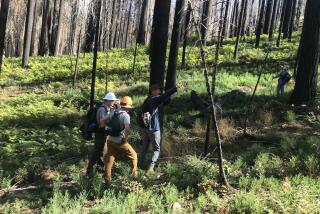Making the Rim fire damage worse
The Stanislaus National Forest was a thickly forested wonderland of streams, wildlife and campgrounds until last summer’s Rim fire — started by a hunter’s illegal campfire — scorched more than 250,000 acres of it and the adjacent Yosemite National Park. To many people, it’s a tragic sight now. What was once dense greenery is now scarred, gray and empty looking.
But nature takes the long view. From its perspective, fire is about rejuvenation. It reinvigorates the soil and stimulates the growth of a greater variety of healthy new plants. Fire, even intense and far-reaching fire, is a part of the natural process dating back thousands of years.
From the point of view of loggers, the fire was good for another reason: It opened an opportunity to pull out lots of lumber. And at first glance, the public might agree. Why not make use of a bunch of dead trees? But that would be a serious mistake.
YEAR IN REVIEW: The good, the bad and the hopeful in wilderness news
Loggers have an ally in Rep. Tom McClintock (R-Elk Grove), whose irresponsible bill would allow almost unfettered timber operations throughout the burn area, heedlessly crushing the forest’s recovery and undermining a history of science-based environmental review that is supposed to govern logging in national forests. Forest science? What forest science?
Heavy machinery would roam the hills, chewing up fragile new growth and pulling out fire-damaged trees before foresters can determine whether they’re alive. And even dead trees have immense value to the recovering forest, stabilizing the bare ground and providing habitat for vast populations of bugs, birds and other creatures.
Logging operations would destabilize the soil and remove plant life that is essential to prevent mud flows and erosion. That’s not just bad for forest recovery but potentially devastating to the watershed of the Merced and Tuolumne rivers. McClintock’s bill calls for replanting the forest, an unnecessary and environmentally dicey proposal.
There is one grain of sense to McClintock’s absurd giveaway to the logging industry. There might be good, damaged but salvageable lumber that can be taken with little if any environmental damage — mainly relatively young trees along existing roads.
But there’s a solution that makes more sense. Congress should appropriate funds for a timely and independent study of Stanislaus recovery, resulting in a plan that allows for limited logging, where appropriate. Replanting might be called for in areas adjacent to inhabited towns to avoid mudslides. But according to forest scientists, most burn areas are best left to regenerate themselves, even those as unimaginably large as the Stanislaus.
More to Read
A cure for the common opinion
Get thought-provoking perspectives with our weekly newsletter.
You may occasionally receive promotional content from the Los Angeles Times.






